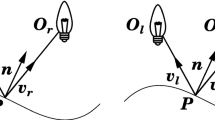Abstract
Helmholtz stereopsis is an advanced 3D reconstruction technique for objects with arbitrary reflectance properties that uniquely characterises surface points by both depth and normal. Traditionally, in Helmholtz stereopsis consistency of depth and normal estimates is assumed rather than explicitly enforced. Further, conventional Helmholtz stereopsis performs maximum likelihood depth estimation without neighbourhood consideration. In this paper, we demonstrate that reconstruction accuracy of Helmholtz stereopsis can be greatly enhanced by formulating depth estimation as a Bayesian maximum a posteriori probability problem. In re-formulating the problem we introduce neighbourhood support by formulating and comparing three priors: a depth-based, a normal-based and a novel depth-normal consistency enforcing one. Relative performance evaluation of the three priors against standard maximum likelihood Helmholtz stereopsis is performed on both real and synthetic data to facilitate both qualitative and quantitative assessment of reconstruction accuracy. Observed superior performance of our depth-normal consistency prior indicates a previously unexplored advantage in joint optimisation of depth and normal estimates. Further, we highlight several known artefacts of Helmholtz stereopsis due to sensor saturations, normal corruption by 2D texture and by intensity sampling at grazing angles and enrich the initially proposed pipeline of Bayesian Helmholtz stereopsis with simple yet effective extensions to tackle the artefacts.
Similar content being viewed by others
References
Baumgard, B.: Geometric Modeling for Computer Vision. Ph.D. thesis, University of Stanford (1974)
Delaunoy, A., Prados, E., Belhumeur, P.N.: Towards Full 3D Helmholtz Stereovision Algorithms. In: Kimmel, R., Klette, R., Sugimoto, A. (eds.) ACCV 2010, Part I. LNCS, vol. 6492, pp. 39–52. Springer, Heidelberg (2011)
Frankot, R., Chellappa, R.: A method for enforcing integrability in shape from shading algorithms. PAMI 10(4), 439–451 (1988)
Guillemaut, J.Y., Drbohlav, O., Illingworth, J., Šára, R.: A maximum likelihood surface normal estimation algorithm for Helmholtz stereopsis. VISAPP 2, 352–359 (2008)
Guillemaut, J.Y., Drbohlav, O., Šára, R., Illingworth, J.: Helmholtz stereopsis on rough and strongly textured surfaces. In: 3DPVT, pp. 10–17 (2004)
Helmholtz, H.: Treatise on Physiological Optics, vol. 1. Dover, New York (1925)
Kazhdan, M., Bolitho, M., Hoppe, H.: Poisson surface reconstruction. In: SGP, pp. 61–70 (2006)
Kolmogorov, V.: Convergent tree-reweighted message passing for energy minimization. PAMI 28(10), 1568–1583 (2006)
Kolmogorov, V., Zabih, R.: What energy functions can be minimized via graph cuts? PAMI 26, 65–81 (2004)
Laurentini, A.: The visual hull concept for silhouette-based image understanding. PAMI 16(2), 150–162 (1994)
Li, S.: Markov random field models in computer vision. In: ECCV, vol. B, pp. 361–370 (1994)
POV-Ray: POV-Ray - The Persistence of Vision Raytracer. http://www.povray.org/ (2013)
Roubtsova, N., Guillemaut, J.Y.: A Bayesian framework for enhanced geometric reconstruction of complex objects by Helmholtz Stereopsis. In: VISAPP (2014)
Scharstein, D., Szeliski, R.: A taxonomy and evaluation of dense two-frame stereo correspondence algorithms. IJCV 47(1–3), 7–42 (2002)
Seitz, S., Curless, B., Diebel, J., Scharstein, D., Szeliski, R.: A comparison and evaluation of multi-view stereo reconstruction algorithms. CVPR 1, 519–528 (2006)
Szeliski, R., Zabih, R., Scharstein, D., Veksler, O., Kolmogorov, V., Agarwala, A., Tappen, M., Rother, C.: A comparative study of energy minimization methods for markov random fields with smoothness-based priors. PAMI 30(6), 1068–1080 (2008)
Tu, P., Mendonça, P.R., Ross, J., Miller, J.: Surface registration with a Helmholtz reciprocity image pair. In: Proceedings of IEEE Workshop on Color and Photometric Methods in Computer Vision (2003)
Wainwright, M.J., Jaakkola, T.S., Willsky, A.S.: Map estimation via agreement on trees: message-passing and linear-programming approaches. IEEE Trans. Inf. Theory 51(11), 3697–3717 (2005)
Weinmann, M., Ruiters, R., Osep, A., Schwartz, C., Klein, R.: Fusing structured light consistency and helmholtz normals for 3D reconstruction. In: BMVC, pp. 108.1–108.12. BMVA Press (2012)
Woodham, R.J.: Shape from shading, chap. Photometric Method for Determining Surface Orientation from Multiple Images, pp. 513–531. MIT Press, Cambridge, MA, USA (1989)
Wu, T.P., Tang, K.L., Tang, C.K., Wong, T.T.: Dense photometric stereo: a markov random field approach. PAMI 28(11), 1830–1846 (2006)
Zickler, T.: Reciprocal image features for uncalibrated Helmholtz stereopsis. In: CVPR, pp. 1801–1808 (2006)
Zickler, T., Belhumeur, P.N., Kriegman, D.J.: Helmholtz stereopsis: exploiting reciprocity for surface reconstruction. IJCV 49(2–3), 215–227 (2002)
Zickler, T.E., Ho, J., Kriegman, D.J., Ponce, J., Belhumeur, P.N.: Binocular helmholtz stereopsis. ICCV 2, 1411–1417 (2003)
Author information
Authors and Affiliations
Corresponding author
Editor information
Editors and Affiliations
Rights and permissions
Copyright information
© 2015 Springer International Publishing Switzerland
About this paper
Cite this paper
Roubtsova, N., Guillemaut, JY. (2015). Extended Bayesian Helmholtz Stereopsis for Enhanced Geometric Reconstruction of Complex Objects. In: Battiato, S., Coquillart, S., Pettré, J., Laramee, R., Kerren, A., Braz, J. (eds) Computer Vision, Imaging and Computer Graphics - Theory and Applications. VISIGRAPP 2014. Communications in Computer and Information Science, vol 550. Springer, Cham. https://doi.org/10.1007/978-3-319-25117-2_14
Download citation
DOI: https://doi.org/10.1007/978-3-319-25117-2_14
Published:
Publisher Name: Springer, Cham
Print ISBN: 978-3-319-25116-5
Online ISBN: 978-3-319-25117-2
eBook Packages: Computer ScienceComputer Science (R0)




